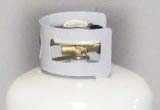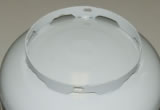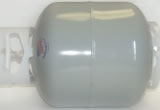Propane Cylinder Requirements
Rules and regulations pertaining to propane cylinders and LP Gas bottles account for their portability and variety of uses. There are many requirements involving cylinder storage, transportation and acceptable use but the requirements related to cylinders themselves are listed and explained here.
Propane Cylinder Protective Collar

The valve of a propane cylinder is required to be protected by a protective cap or collar, also called a neck ring. The absence of a protective collar leaves the cylinders valve(s) susceptible to serious damage. An unprotected valve hit hard enough can break off allowing liquid propane to escape at a dangerously fast rate. The escaping propane can act as propulsion for the cylinder allowing it to become a dangerous projectile. The collar also serves as the location for required markings pertinent to the cylinder's construction data and specifications. Without the protective collar, a propane cylinder is unfit for continued propane use and illegal to fill. See a picture of the valve damage that can occur when the protective collar is missing.
Cylinder Foot Ring

The bottom of all propane cylinders are required to have a foot ring. The foot ring serves a very vital role in the protection and continued usability of a propane cylinder. The foot ring ensures the LP Gas cylinder stands in an upright and level position while also keeping the storage container from contacting the ground. Foot rings act as the "legs" of the cylinder and the absence of a foot ring would allow the bottle to easily fall on its side and roll around. If this occurred while the cylinder was in use, liquid may enter the service valve and hose resulting in a dangerous situation. Cylinders without a foot ring are unfit for LP Gas use and are illegal to refill. See a picture of a damaged propane cylinder foot ring.
Cylinder Container

The cylinder container makes up the bulk of the actual cylinder itself. The container is where the propane is stored while all other parts and appurtenances are attached by welds or threads. The container, made commonly of steel or aluminum should be free of bulges and dents. Being portable, propane cylinders are subject to rougher treatment than a stationary tank and are far more likely to be banged up in transport and handling. Dents in the container surface are more common than bulges but they both render a cylinder unfit for use. Dents and bulges compromise the integrity of a propane container and although the cylinder might safely continue in service, Federal requirements state the cylinder be removed from service.
Additional Propane Cylinder Requirements
- Consumer propane cylinders 4-40# are required to be equipped with an OPD (Overfill Protection Device) Valve.
- All propane bottles are subject to Cylinder Recertification and Requalification.
- All propane bottles are subject to requirements before and during Cylinder Filling.
